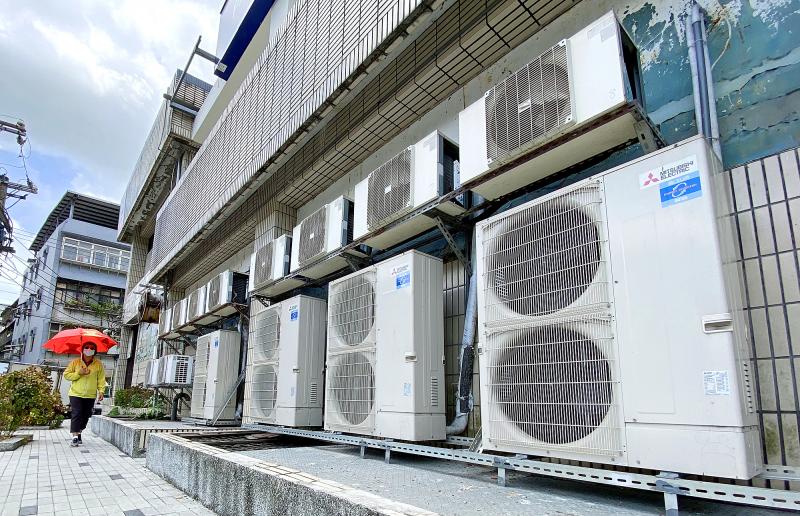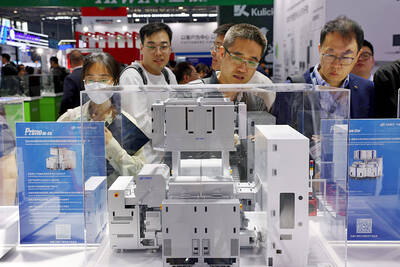Summer electricity rates that could be up to 27 percent higher than normal are to take effect tomorrow until Sept. 30, although more than 3.6 million households should not be affected by the steeper costs, state-run Taiwan Power Co (Taipower, 台電) said yesterday.
The summer rate mechanism was first implemented in 1989 to encourage consumers to conserve electricity during peak usage months, it said.
The average household consumed 443 kilowatt-hours (kWh) each month during summer last year, compared with 312kWh per month during other seasons, Taipower data showed.

Photo: CNA
The average household electricity bill was NT$459 higher per month from June to September last year than in other months, with NT$335 — 74.6 percent — a result of higher power consumption and NT$124 due to the higher rates, Taipower said.
Taiwanese pay for electricity based on a six-level progressive tariff model, which charges more per kilowatt-hour the more power a household uses, regardless of the season.
Under the model, households pay the standard base level of NT$1.63 per kilowatt-hour for the first 120kWh of power used during the summer. Last year, 3.68 million households fell into this category.
Households that consume more than 120kWh a month are to be charged an additional 13 to 27 percent of the base rate under the progressive rate system, with households using more than 1,000kWh a month subject to the maximum rate.
Only 2.8 percent of households used more than 1,000kWh a month last year.
Households that consume 121kWh to 330kWh per month, of which there were 4.97 million last year, are to pay an additional NT$0.28 per kilowatt-hour — 13 percent more — over the standard NT$2.15 per kilowatt-hour rate during the summer, Taipower said.
Households that use 331kWh to 550kWh a month are to pay a 22 percent premium for electricity during the summer, while households consuming 501kWh to 700kWh and 701kWh to 1,000kWh of power a month are to pay 22 percent and 23 percent more respectively.

With this year’s Semicon Taiwan trade show set to kick off on Wednesday, market attention has turned to the mass production of advanced packaging technologies and capacity expansion in Taiwan and the US. With traditional scaling reaching physical limits, heterogeneous integration and packaging technologies have emerged as key solutions. Surging demand for artificial intelligence (AI), high-performance computing (HPC) and high-bandwidth memory (HBM) chips has put technologies such as chip-on-wafer-on-substrate (CoWoS), integrated fan-out (InFO), system on integrated chips (SoIC), 3D IC and fan-out panel-level packaging (FOPLP) at the center of semiconductor innovation, making them a major focus at this year’s trade show, according

DEBUT: The trade show is to feature 17 national pavilions, a new high for the event, including from Canada, Costa Rica, Lithuania, Sweden and Vietnam for the first time The Semicon Taiwan trade show, which opens on Wednesday, is expected to see a new high in the number of exhibitors and visitors from around the world, said its organizer, SEMI, which has described the annual event as the “Olympics of the semiconductor industry.” SEMI, which represents companies in the electronics manufacturing and design supply chain, and touts the annual exhibition as the most influential semiconductor trade show in the world, said more than 1,200 enterprises from 56 countries are to showcase their innovations across more than 4,100 booths, and that the event could attract 100,000 visitors. This year’s event features 17

Germany is to establish its first-ever national pavilion at Semicon Taiwan, which starts tomorrow in Taipei, as the country looks to raise its profile and deepen semiconductor ties with Taiwan as global chip demand accelerates. Martin Mayer, a semiconductor investment expert at Germany Trade & Invest (GTAI), Germany’s international economic promotion agency, said before leaving for Taiwan that the nation is a crucial partner in developing Germany’s semiconductor ecosystem. Germany’s debut at the international semiconductor exhibition in Taipei aims to “show presence” and signal its commitment to semiconductors, while building trust with Taiwanese companies, government and industry associations, he said. “The best outcome

Semiconductor equipment billings in Taiwan are expected to double this year, as manufacturers in the industry are keen to expand production to meet strong global demand for artificial intelligence applications, according to SEMI, which represents companies in the electronics manufacturing and design supply chain. Speaking at a news conference before the opening of Semicon Taiwan trade show tomorrow, SEMI director of industry research and statistics Clark Tseng (曾瑞榆) said semiconductor equipment billings in Taiwan are expected to grow by an annual 100 percent this year, beating an earlier estimate of 70 percent growth. He said that Taiwan received a boost from a